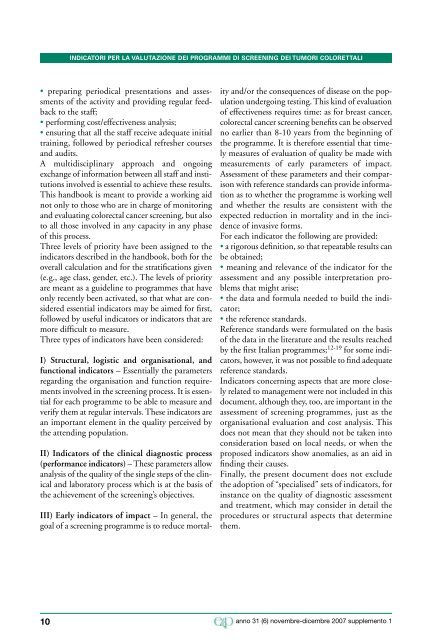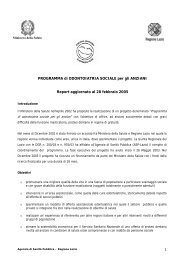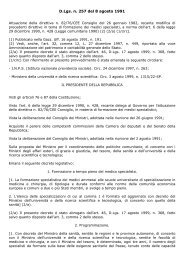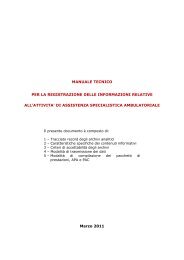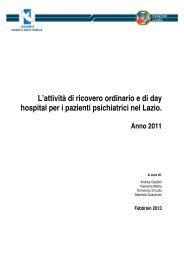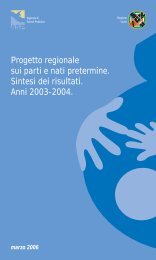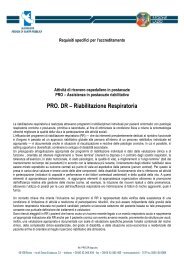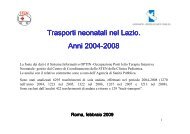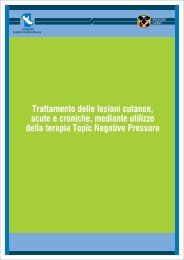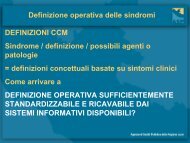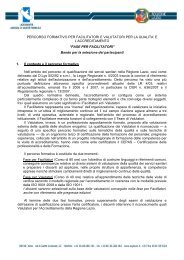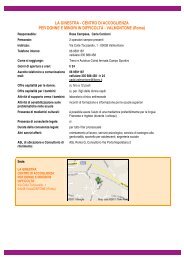Indicatori di qualità per la valutazione dei programmi di screening ...
Indicatori di qualità per la valutazione dei programmi di screening ...
Indicatori di qualità per la valutazione dei programmi di screening ...
Create successful ePaper yourself
Turn your PDF publications into a flip-book with our unique Google optimized e-Paper software.
INDICATORI PER LA VALUTAZIONE DEI PROGRAMMI DI SCREENING DEI TUMORI COLORETTALI<br />
• preparing <strong>per</strong>io<strong>di</strong>cal presentations and assessments<br />
of the activity and provi<strong>di</strong>ng regu<strong>la</strong>r feedback<br />
to the staff;<br />
• <strong>per</strong>forming cost/effectiveness analysis;<br />
• ensuring that all the staff receive adequate initial<br />
training, followed by <strong>per</strong>io<strong>di</strong>cal refresher courses<br />
and au<strong>di</strong>ts.<br />
A multi<strong>di</strong>sciplinary approach and ongoing<br />
exchange of information between all staff and institutions<br />
involved is essential to achieve these results.<br />
This handbook is meant to provide a working aid<br />
not only to those who are in charge of monitoring<br />
and evaluating colorectal cancer <strong>screening</strong>, but also<br />
to all those involved in any capacity in any phase<br />
of this process.<br />
Three levels of priority have been assigned to the<br />
in<strong>di</strong>cators described in the handbook, both for the<br />
overall calcu<strong>la</strong>tion and for the stratifications given<br />
(e.g., age c<strong>la</strong>ss, gender, etc.). The levels of priority<br />
are meant as a guideline to programmes that have<br />
only recently been activated, so that what are considered<br />
essential in<strong>di</strong>cators may be aimed for first,<br />
followed by useful in<strong>di</strong>cators or in<strong>di</strong>cators that are<br />
more <strong>di</strong>fficult to measure.<br />
Three types of in<strong>di</strong>cators have been considered:<br />
I) Structural, logistic and organisational, and<br />
functional in<strong>di</strong>cators – Essentially the parameters<br />
regar<strong>di</strong>ng the organisation and function requirements<br />
involved in the <strong>screening</strong> process. It is essential<br />
for each programme to be able to measure and<br />
verify them at regu<strong>la</strong>r intervals. These in<strong>di</strong>cators are<br />
an important element in the quality <strong>per</strong>ceived by<br />
the atten<strong>di</strong>ng popu<strong>la</strong>tion.<br />
II) In<strong>di</strong>cators of the clinical <strong>di</strong>agnostic process<br />
(<strong>per</strong>formance in<strong>di</strong>cators) – These parameters allow<br />
analysis of the quality of the single steps of the clinical<br />
and <strong>la</strong>boratory process which is at the basis of<br />
the achievement of the <strong>screening</strong>’s objectives.<br />
III) Early in<strong>di</strong>cators of impact – In general, the<br />
goal of a <strong>screening</strong> programme is to reduce mortal-<br />
10<br />
ity and/or the consequences of <strong>di</strong>sease on the popu<strong>la</strong>tion<br />
undergoing testing. This kind of evaluation<br />
of effectiveness requires time: as for breast cancer,<br />
colorectal cancer <strong>screening</strong> benefits can be observed<br />
no earlier than 8-10 years from the beginning of<br />
the programme. It is therefore essential that timely<br />
measures of evaluation of quality be made with<br />
measurements of early parameters of impact.<br />
Assessment of these parameters and their comparison<br />
with reference standards can provide information<br />
as to whether the programme is working well<br />
and whether the results are consistent with the<br />
expected reduction in mortality and in the incidence<br />
of invasive forms.<br />
For each in<strong>di</strong>cator the following are provided:<br />
• a rigorous definition, so that repeatable results can<br />
be obtained;<br />
• meaning and relevance of the in<strong>di</strong>cator for the<br />
assessment and any possible interpretation problems<br />
that might arise;<br />
• the data and formu<strong>la</strong> needed to build the in<strong>di</strong>cator;<br />
• the reference standards.<br />
Reference standards were formu<strong>la</strong>ted on the basis<br />
of the data in the literature and the results reached<br />
by the first Italian programmes; 12-19 for some in<strong>di</strong>cators,<br />
however, it was not possible to find adequate<br />
reference standards.<br />
In<strong>di</strong>cators concerning aspects that are more closely<br />
re<strong>la</strong>ted to management were not included in this<br />
document, although they, too, are important in the<br />
assessment of <strong>screening</strong> programmes, just as the<br />
organisational evaluation and cost analysis. This<br />
does not mean that they should not be taken into<br />
consideration based on local needs, or when the<br />
proposed in<strong>di</strong>cators show anomalies, as an aid in<br />
fin<strong>di</strong>ng their causes.<br />
Finally, the present document does not exclude<br />
the adoption of “specialised” sets of in<strong>di</strong>cators, for<br />
instance on the quality of <strong>di</strong>agnostic assessment<br />
and treatment, which may consider in detail the<br />
procedures or structural aspects that determine<br />
them.<br />
anno 31 (6) novembre-<strong>di</strong>cembre 2007 supplemento 1


